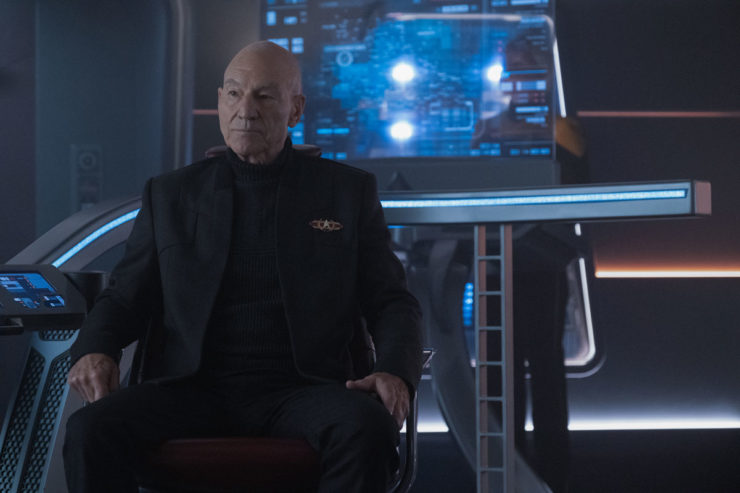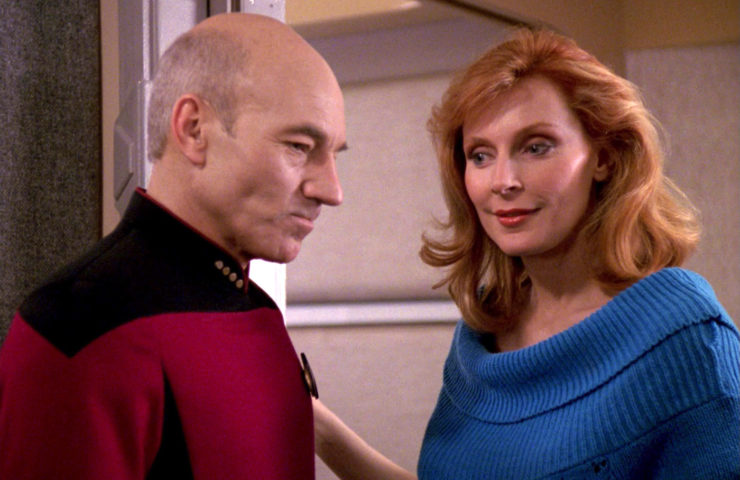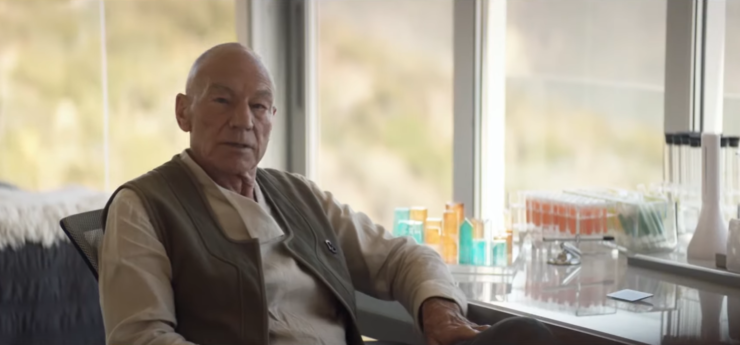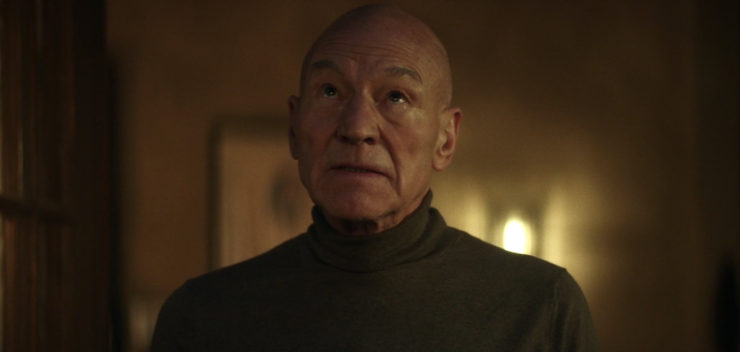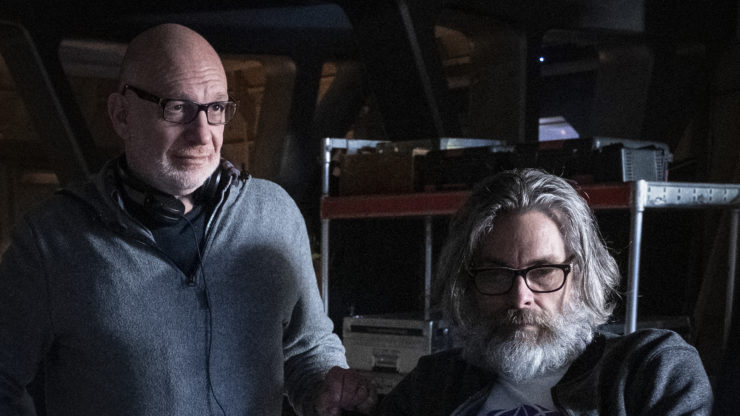When he was approached by Secret Hideout to revive the role of Jean-Luc Picard, Sir Patrick Stewart reportedly did not wish to just do a sequel to The Next Generation, but wanted to explore new horizons with the character. Whatever the flaws of Star Trek: Picard’s first season, it did do that. Then we had the unfocused mess that was season two, and now here we are in season three of Picard, which is the very sequel to TNG that Stewart allegedly didn’t want to do.
And I still don’t know how I feel about it.
On the one hand, as someone who loved TNG for all seven seasons that it was on the air and for all four movies the crew starred in (for all that three of the four of them were really terrible), and as someone who has written these characters in multiple works of prose fiction, I’m thrilled at the notion of revisiting them two decades after we last saw them.
On the other hand, I totally get where Stewart was coming from in his reported initial objection. And the first season of Picard gave us a very nifty supporting cast that was then mostly dismantled or ignored, with two notable exceptions, one of whom was an already-established popular character from the same era as TNG, the Voyager character of Seven of Nine played by Jeri Ryan. The other is Raffi Musiker, played by the magnificent Michelle Hurd, and while she’s still here, her plot isn’t (yet) connected to our main story of bringing the band back together. (Okay, and Orla Brady, but she’s been reduced to a guest star, and is used decently in the opening scenes and then shuffled off. It’s clear she’s only there because Picard chose to be with her at the end of season two, so they have to at least write her out convincingly, but she’s definitely being written out, given Brady’s removal from the “opening” credits. (I put “opening” in quotes because Picard is joining the idiotic trend in recent times to put all the credits at the end, a tendency I utterly despise and wish would reverse. (At least the other Trek shows don’t do it. (At least not yet. (I don’t know why I’m nesting so many parentheticals here. (Probably just being self-indulgent…))))))
I will give show-runner (and writer of this first episode) Terry Matalas credit for this: he’s slow-rolling the reunion. We don’t get the entire gang in this one, just Dr. Beverly Crusher (Gates McFadden), who is only really in the opening scene, and the return of Jonathan Frakes as Captain William Riker. We don’t see any of the rest of the gang yet, though both La Forge and Troi are mentioned. This is, to my mind, the right approach, not overloading the viewer and giving every character a chance to be reintroduced on their own.
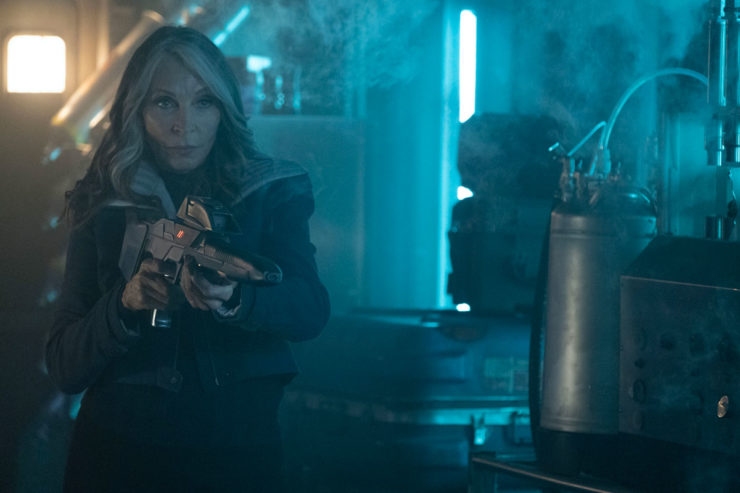
We open on Crusher, who is flying around on a ship with just one other person, who we find out at the end of the episode is her son. She’s listening to the log report Picard recorded in “The Best of Both Worlds,” and is being chased by alien ships. They board and Crusher is rather bloodthirsty in killing them. Yes, she’s defending herself, but still, this is icky. But she’s also very obviously exhausted and frightened and at her wits’ end.
She contacts Picard, and does so by using a frequency that is specifically designed to be picked up only by Picard’s old Enterprise-D combadge, encrypted with a codec that Picard would know to use, and also using a code that was used on the Enterprise-D when the Borg messed with their computers.
The latter is something Picard needs Riker for, as he was busy being Locutus when they came up with that code, which is called “Hellbird.” They meet at Ten-Forward, as Riker is in town to give a speech on Frontier Day.
This is also the first Picard—or, based on his conversation with Riker, any of the gang—have heard from Crusher in twenty years. She cut herself off from everyone some time shortly after Nemesis, and nobody knows why, nor expected not to hear from her at all for two decades.
Crusher’s message urges Picard to not trust anyone, an instruction Picard immediately ignores by first sharing the message with Laris, then by contacting Riker. Crusher also says not to involve Starfleet. Riker’s solution is to try to commandeer the Titan. Which is a Starfleet ship.
That moment threw me entirely out of the episode. Riker offhandedly says it’s too far and too dangerous to charter a ship, a comment that makes absolutely no sense. It especially makes no sense on a TV show large chunks of which have taken place on La Sirena, a civilian ship that Picard chartered for an unauthorized mission. Instead, La Sirena is being used by Musiker for her side plot. (Remember, the version of La Sirena they used in season two to go back in time that the Jurati Borg Queen made off with was the one from the alternate timeline of the Confederation. The main timeline one is still around, as we see here.) But even stipulating to that, there have to be tons of civilian ships they could have hired without having to ignore Crusher’s wishes.
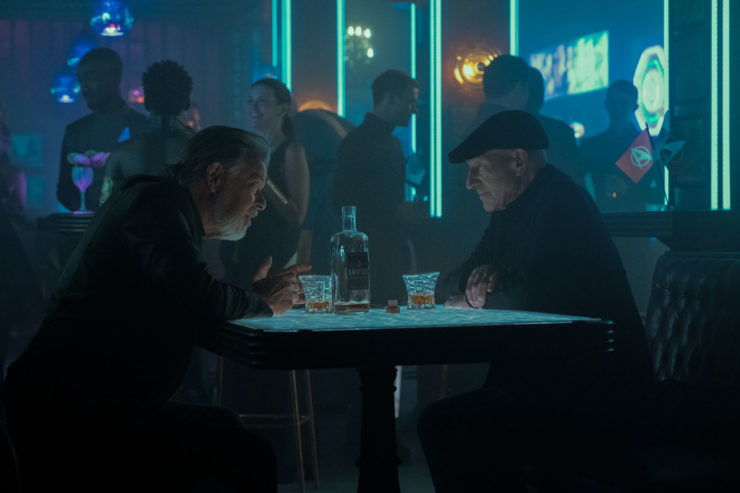
But no, Picard and Riker go to Titan for a surprise inspection, and the hope that they can trick/convince a Starfleet captain to go to Crusher’s coordinates. Instead of, y’know, hiring a ship on which they can instruct the captain what to do with no questions asked. Sure, that makes sense.
Once we arrive at Titan‘s berth in Spacedock, I’m thrown out of the episode for a second time. This isn’t the Titan that Riker commanded, as seen in Lower Decks and in several novels, both of which used the design created by Sean Tourangeau, who won the design-the-Titan contest that Simon & Schuster held in 2005. No, this is a new Titan, which is “neo-Constitution-class,” whatever the hell that means. It’s less interesting than Tourangeau’s design, and all I can think looking at the new ship is that it’s an attempt at pseudo-nostalgia by making it look sorta-kinda like Kirk’s Enterprise, at the expense of Tourangeau’s much better design. (At least we still have it on LD.)
The good news is that Titan has a friendly face as her new first officer: Seven—or, rather, Commander Annika Hansen. After season two’s events, Seven decided—at, according to her, the urging of both Admirals Picard and Janeway—to join Starfleet. Her experiences on Voyager were enough to give her a commission at the rank of commander, and she’s been assigned to Titan under Captain Liam Shaw.
Since the title character is an admiral, we can’t do the Evil Admiral cliché, so we substitute with the Evil Captain. Shaw, played with gleeful smarm by Todd Stashwick, is in the tired tradition of Decker, Tracey, Garth, Esteban, Maxwell, Ransom, etc., ad nauseum. The deck is so totally stacked against him it bleeds into the absurd. He insists that Seven refer to herself as Hansen, a cruel and unnecessary insistence. He invites Picard and Riker to dinner, but starts eating before they arrive—and also leaves before they finish, which would be appallingly rude even if they weren’t VIP guests. At the gift of a bottle of Château Picard, he dismissively says he prefers Malbec (a Spanish wine), and he also makes his disdain for jazz clear, commenting that he had to delete all the jazz Riker had in the databanks when he took command. And finally, the guest quarters for an admiral and a captain that he provides is a single room they have to share with bunk beds, which is a protocol violation of the highest order.
Oh, and he refuses to change course as Picard requests, as Picard is a retired admiral, and Riker isn’t captain of this ship anymore. I mean, he’s right, but that doesn’t make him any less of a dick.
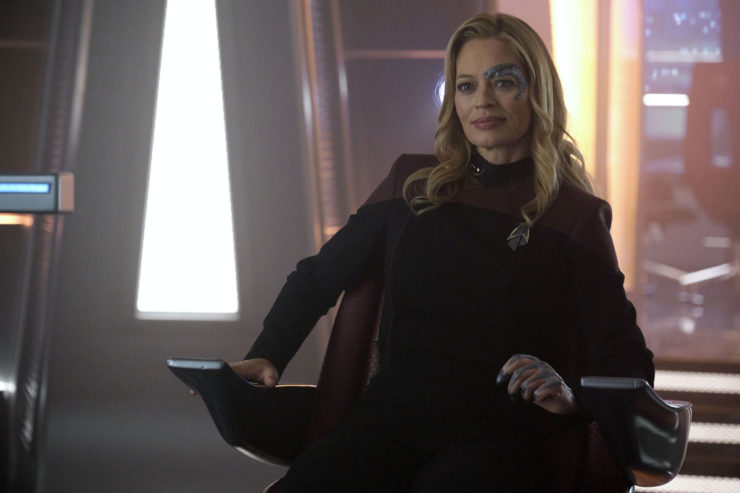
Luckily, the first officer is on their side. Picard takes her into his confidence, mostly by her bullying him into it. When she snaps at Picard, Riker snaps right back, asking if that’s how she talks to an admiral. Seven tartly retorts that that’s how she talks to a friend. Picard explains the mission, and only after that do they find out that Seven had already changed course to the coordinates Picard got from Crusher.
Seven also facilitates their stealing a shuttle, and they head over to Crusher’s ship, only to find the good doctor in stasis and a young man on board who identifies himself as Crusher’s son. He berates the two of them for leading “them” to us, and the episode ends with the same bad-guy aliens from the top of the episode showing up.
We don’t know who this guy is, but he’s around twenty years old and speaks with a British accent, so it looks like we’re going to live the cliché and have him also be Picard’s kid. That’s my guess, anyhow, and I hope it’s wrong, because that’s just too obvious…
Crusher (and maybe Picard?) is not the only one with a surprise kid. They also pull a Demora-in-Generations and have the Titan conn officer be Ensign Sidney La Forge, Geordi’s daughter, played by Ashlei Sharpe Chestnut. On the one hand, I like this showing that the crew of the Big E finally have done other things with their lives. On the other hand, if we find out that Leah Brahms is Sidney’s mother, I swear I will riot. Or, at the very least, rant at great length on the subject in the review I write of the episode where that is revealed…
Speaking of families, we also have a troubling line from Riker. When Picard apologizes for taking him away from his family, Riker gravely says, “Deanna and Kestra will appreciate the time away from me.” That sounds ominous and not a lot of fun, and completely unnecessary. But I’ll reserve judgment until that’s more than a single line of dialogue…
Buy the Book


Wild Massive
There are some wonderful bits in this episode. For starters, there’s the double act of Stewart and Frakes. The producers of TNG recognized the value of this pairing early on, first seen overtly in “11001001,” and which continued to be a strong captain/first officer relationship throughout TNG and the four followup films, not to mention Riker’s prior appearances on Picard. It’s in full bloom in “The Next Generation,” and much of the joy of watching this episode is seeing these two together again.
(Also what is it with the recent trend to lazy season premiere titles? First Strange New Worlds decides that the title of their first episode will be “Strange New Worlds,” and now the debut of the season of Picard that will reunite the crew from The Next Generation is called “The Next Generation.” You can do better than this, guys…)
In addition, we have some little touches like the souvenir Enterprise-D models in Ten-Forward. Picard and Laris are looking at some of the things he has around the house, including a painting of the Enterprise-D (which Picard says is his favorite, a bit of fan-service that I call bullshit on, and would direct folks to the holodeck scene with Picard and Scotty in “Relics”—the Stargazer was his favorite, dagnabbit), and the Ressikan flute from “The Inner Light,” which he clutches fondly. And I must confess to loving that the episode opens with “I Don’t Want to Set the World on Fire” by the Ink Spots…
However, it’s telling that the part of the episode I found most compelling were the scenes with Musiker. When we first see Picard’s former aide, it seems like she’s fallen off the wagon, desperate to get a fix. Luckily, that’s not the case—she’s just working an undercover op for Starfleet Intelligence, though she doesn’t know who her handler is (and neither do we). She’s trying to track down the Red Lady, and while she does figure it out eventually, it’s not soon enough, as a Starfleet facility is destroyed. (In a nice touch, the facility was about to have a dedication of a statue of Rachel Garrett, the captain of the Enterprise-C, seen in “Yesterday’s Enterprise.”) Musiker is also struggling, as she is an addict, and even in the twenty-fifth century, it’s easy to be tempted to go back to the substances that made you temporarily feel good. Hurd plays it brilliantly, both the initial viewing of Musiker where we think she’s back to being a junkie, and then her angry and plaintive conversation with her unknown handler about how difficult this assignment is.
In the end, my feelings on this premiere match my feelings about this show in general, which I summarized in my review of the second-season finale, “Farewell”:
“There are parts … that I adored. There are parts where I cheered loudly. There are parts where I wanted to throw my shoe at the screen. There are parts where I was just staring at the TV wondering WTF I just watched. And there are parts where I just yelled, ‘Oh, come on, really?????’”
We’ll see if that’s still the case next week, when, presumably, we’ll see more of the gang…
Keith R.A. DeCandido has a new Trek story coming out in April: “You Can’t Buy Fate,” which will be in issue #7 of Star Trek Explorer.










